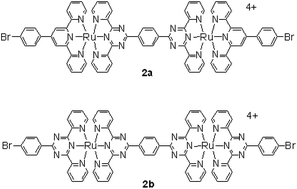Understanding the redox properties of dinuclear ruthenium(ii) complexes by a joint experimental and theoretical analysis†
Abstract
A combined experimental and theoretical approach has been used to investigate the redox properties of two dinuclear Ru(II) complexes, 2a and 2b, containing the planar dpt–ph–dpt bridging ligand (dpt–ph–dpt = 1′′,4′′-bis(2,4-dipyrid-2′-yl-1,3,5-triazin-6-yl)benzene). The redox properties of the free bridging ligand and the X-ray structure of 2a have also been reported, together with the X-ray structure of a related mononuclear compound, for comparison purposes. The photophysical processes of 2a and 2b have also been studied by pump–probe transient absorption spectroscopy. Compounds 2a and 2b are able to reversibly collect six and eight electrons, respectively, upon electrochemical reduction at mild potentials (>−2.0 V vs. SCE). A detailed assignment of the various reduction processes to specific subunits of the dinuclear arrays has been made possible by calculation of the HOMOs and LUMOs of native and bireduced species. For example, computation allowed us to clarify the redox behavior of 2b: the first reduction processes of this compound occur at almost coincident potentials, with successive electrons added on the same subunit (namely, the bridging ligand). Charge redistribution towards the other subunits of the molecular framework upon second reduction, revealed by calculation performed on the bireduced species, is the key to interpreting this peculiar behavior. Inter-ligand electron hopping interconverts the MLCT state involving the peripheral ligand to that of the (lower-lying) MLCT state that involves the bridging ligand. This process is faster than 350 fs in 2a, where its driving force is higher than 0.2 eV, whereas it occurs with a time constant of about 6 ps in 2b, having a smaller driving force for the process. Both compounds decay to the ground state, with MLCT emission on the nanosecond time scale, however a faster component of such decay is kinetically evidenced, indicating a process of about 200–250 ps in both cases, which is tentatively assigned to relatively slow diffusive solvent dynamics.


 Please wait while we load your content...
Please wait while we load your content...